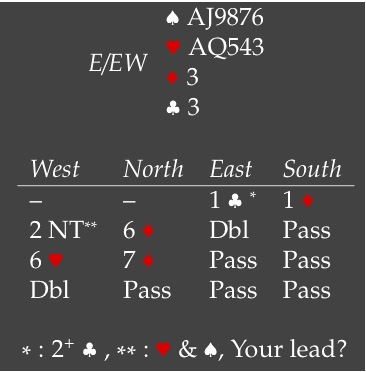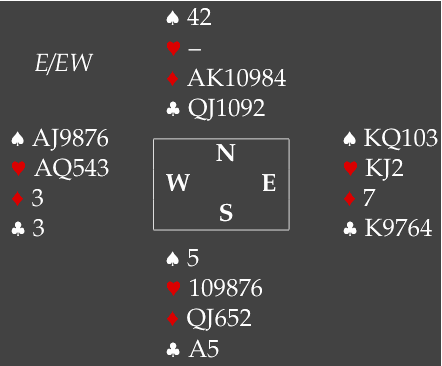 Last month, the final of the Dutch top-circuit was played. The top circuit is an IMP-pairs tournament, open to only the strongest players in the country. It consists of 4 qualifying rounds (45 boards each), followed by a final with the 16 strongest pairs. There is no carry-over. To enter, a pair has to meet at least one of these five conditions:
Last month, the final of the Dutch top-circuit was played. The top circuit is an IMP-pairs tournament, open to only the strongest players in the country. It consists of 4 qualifying rounds (45 boards each), followed by a final with the 16 strongest pairs. There is no carry-over. To enter, a pair has to meet at least one of these five conditions:
- At least 1 player plays in the top 2 flights of the open Dutch teams. These flights are called “Meesterklasse” (Master Class) and 1st division. The third flight is called 2nd division.
- At least 1 player plays in the top flight of the open Dutch pairs competition.
- The pair is a member of one of the international teams (open, women, senior, youth).
- The pair qualified for last year’s final.
- The pair gets a wild-card from the organizing committee.
There is a limit of 60 pairs that can enter, if there are more entries, the organizing committee will select the strongest pairs. At a first glance, it looks as if this will create the strongest 60 pair field in the country.
Yesterday evening, I was reading the April issue of Bridge Magazine IMP and noticed that in 2 articles, the respective authors (Jan van Cleeff in the report on the final, Paul Felten in his column) had some comments on the event, in particular the strength of the field. The points were similar, to summarize them:
- First point was that the event was not as strong as it could be, mainly because too many players of 2nd division (that is the 3rd flight in our national team competition) entered.
- Second, not all top pairs we currently have participated.
I am not sure where the first point is coming from, if one looks at the list of participants, only 6 or 7 out of 60 pairs are 2nd division players, the others all met the first two criteria. That is about 10%, removing that group does not make a field significantly stronger.
The second point is correct, 2 pairs from our world champion team were indeed missing, as were a number of other players from the teams in the top division. Now, the pairs from the Bermuda Bowl team have a very full program and will have to make choices which events to enter. Other players in the top division are almost all amateurs, with a job, a family and other obligations besides bridge too. There are some 70 to 80 pairs eligible for this event, if 60 of them show up, then one has a very good turn-out. I don’t think you can improve much on that.
In short, sorry Jan and Paul, but the facts don’t support your criticism.
That doesn’t mean that the event cannot be improved though. While thinking about it, I came up with these ideas:
- The conditions of contest specify that a pair can enter if one of the players is a member of a team that plays in the 2 top divisions of the national team competition, or the top division of the national pair competition. This opens the door for pairs consisting of a pro playing with a sponsor. At least 3 such pairs appear to have entered this year, with sponsors who are well below the average standard. If one changes this condition such that both players must play in one of the top competitions, those pairs are removed.
- The movement used during the qualifiers. Currently, the movement is such that the field is divided into 4 groups of 15 pairs. On each qualifying day, a group plays 15 3-board rounds against another group (with some small adjustments to deal with absent pairs). It is a scrambled movement (that is, pairs change direction from NS to EW) in order to create one winner of each qualifying round. One has to wonder why this movement is being used. Here’s why. IMP pairs has an intrinsic luck factor. On some boards, all that is at stake, can be a single imp for an overtrick. On another boards, 20 or more imps can be at stake. Consider the problem on the right if you want to see such a hand.

Now, this is a luck factor, you want to play the complex hand against a bad pair, the easy hand against a good one, but not something you can do anything about.
What most people don’t realize though, is that there is a second important factor here: which pairs are playing in the same direction. In a scrambled movement, that group will change every round, sometimes it will be better than average, sometimes it will be worse. This is another luck factor but this is one that can be ruled out easily by using a regular (or unscrambled) movement. It should be noted that there is no reason to have an overall winner of the qualifiers, one just has to select the 16 strongest pairs.
With that in mind, here is my next suggestion for improvement. Take the 60 pairs and split them into 2 equally strong groups of 30. Now run the event as a simple Mitchell, with one of the groups sitting NS and the other EW. Play 30 3-board rounds (over 2 days) against all other pairs. After 30 rounds, all pairs in one group will have had the same opponents and have had their scores compared to the same field on each board. Repeat for the 2 other qualifying rounds. After 4 qualifiers, qualify the top 8 from each of the 2 groups. This reduces the luck factor in the qualifying.
3.Finally, one theoretically has to play as well as one can until the last board, but in practice, lots of players don’t really care about their score when it is clear that they have dropped out of contention. This happens here as well, if one looks at the results of the last qualifying round, then all but 3 pairs in the bottom quarter of the event scored well below 0, 2 pairs scored about 0 and only 1 pair scored above average (+20). All these pairs knew, at the start of the last day, that they needed a minor miracle in order to qualify: Their scores averaged around -40, qualification usually requires a score of about +50, so they have to score +90 in a strong field. Those pairs are unlikely to play to the best of their abilities.
Similar events in the rest of the world are usually played in 3 stages: qualifier, semi-finals, finals. That can be done here as well. Start with 2 days of qualifying, with 60 pairs playing a regular Mitchell. After 2 days, advance the top 40 (top 20 in each direction) of the field. Now play another Mitchell, this time 2 groups of 20 with 4 board rounds. Then, qualify the top 8 in each direction to the final. No carry over between rounds. The advantage: at all stages, one plays against opponents who are still in the running for the next day of play.
A side advantage of a 3 stage approach is that one can give byes into the semi-finals to pairs of the national teams who have other obligations during the first qualifying round. It also solves another problem: pairs can now skip one of the qualifying rounds. That opens a possibility to game the system. If one did well in qualifier 1 and 2, the best tactic is to try to score average in qualifier number 3 and not show up for number 4. With a 2 step approach, this becomes impossible, one has to play every board.
Note: one currently pays an entry fee for the entire event (4 to 6 days). With this model, that should be changed, for example, instead of paying 200 euro for 4 qualifying rounds, pay 100 for the first 2 days, then another 100 if one makes it to the semi-finals.
So much for my suggestions to improve next year’s edition of the White House Top Circuit.

The solution to opening lead problem. At the table, West thought that NS were more likely to be void in his long suit and decided to cash the ace in his short suit. Not completely unreasonable, though one should wonder if north will bid 7♦ without being prepared for a heart lead. Seconds later, the opponents claimed +1630 for -15 imps. On a spade lead, he scores +100 for +11, a difference of 26 imp’s.
